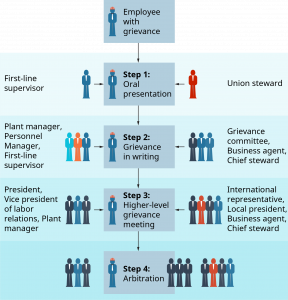9.8 Managing Grievances and Conflicts
- How are grievances between management and labor resolved, and what tactics are used to force a contract settlement?
In a unionized work environment, employees follow a step-by-step process for handling grievances or disputes between management and labor. Conflicts over contracts, however, are far more challenging to resolve and may result in the union or employer imposing economic pressure, as described in this section.
Grievance Handling and Arbitration
The union’s main way of policing the contract is the grievance procedure. A grievance is a formal complaint by an employee or the union that management has violated some part of the contract. Under a typical contract, the employee starts by presenting the grievance to the supervisor, either in person or in writing. The typical grievance procedure is illustrated in Exhibit 9.8 An example grievance is a situation in which an employee is disciplined with a one-day suspension (and loss of pay) for being late for work several times in one month.
If the problem isn’t solved, the grievance is put in writing. The employee, one or more union officials, the supervisor, and perhaps the plant manager then discuss the grievance. If the matter still can’t be resolved, another meeting takes place with higher-level representatives of both parties present. If top management and the local union president can’t resolve the grievance, it goes to arbitration.
Arbitration is the process of settling a labor-management dispute by having a third party—a single arbitrator or a panel—make a decision. The decision is final and binding on the union and employer. The arbitrator reviews the grievance at a hearing and then makes the decision, which is presented in a document called the award. In the one-day suspension mentioned above, the arbitrator might rule that the discipline was improperly made because the employee’s attendance record for the month was not accurately maintained by the firm.

Tactics for Pressuring a Contract Settlement
Virtually all labor agreements specify peaceful resolution of conflicts, usually through arbitration. However, when a contract expires and a new agreement has not been reached, the union is free to strike or engage in other efforts to exert economic pressure on the employer. A strike occurs when employees refuse to work. The United Auto Workers union used a selective strike strategy, a strategy of conducting a strike at a critical plant that supplies parts to other plants, against General Motors. The union conducted its strike at a stamping and parts facility in Flint, Michigan, that supplied critical parts to other plants. The 54-day strike caused the company to stop production at many of its assembly plants because parts were not available from the Flint plant. General Motorslost approximately $2.2 billion during that dispute. Likewise, the employer can put pressure on the union through a lockout or by hiring strike replacements if the union has called a strike. For example, in 2018 aluminum producer Alcoa locked out more than 1,000 union workers from its smelter facility in Quebec, Canada, after union members went on strike.16 Table 9.5provides a summary of union and employer pressure strategies for forcing a contract settlement.
| Strategies of Unions and Employers | |||
|---|---|---|---|
| Union Strategies | Employer Strategies | ||
| Strike: | Employees refuse to work. | Lockout: | Employer refuses to let employees enter plant to work. |
| Boycott: | Employees try to keep customers and others from doing business with employer. | Strike replacements: | Employer uses nonunion employees to do jobs of striking union employees. |
| Picketing: | Employees march near entrance of firm to publicize their view of dispute and discourage customers. | Mutual-aid pact: | Employer receives money from other companies in industry to cover some of income lost because of strikes. |
| Corporate campaign: | Union disrupts stockholder meetings or buys company stock to have more influence over management. | Shift production: | Employer moves production to nonunion plant or out of country. |
CONCEPT CHECK
- Describe the grievance procedure.
- In what ways do arbitrators act like judges?
- What are some tactics for pressuring for a contract settlement?
Source contents: Principles of Management and Organizational Behavior. Please visit OpenStax for more details: https://openstax.org/subjects/view-all

